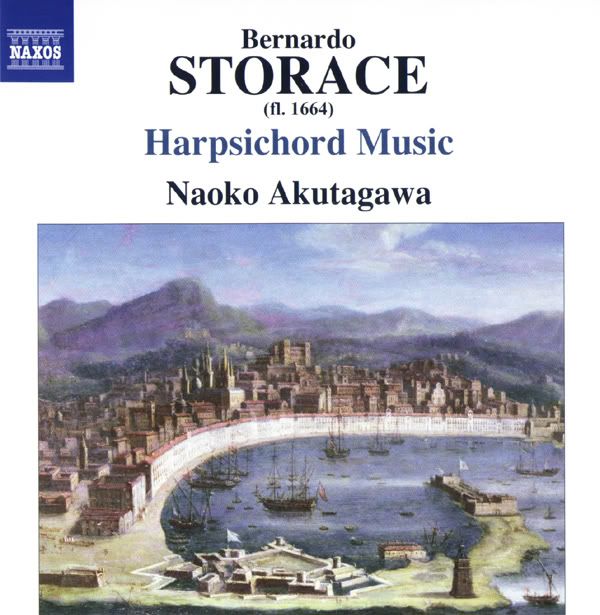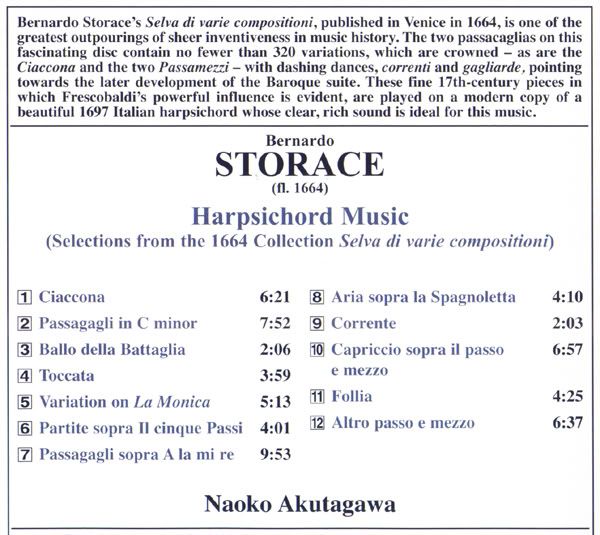 |
| Àðòèñò: |
Naoko Akutagawa - harpsichord |
| Àëüáîì: |
Bernardo Storace - Harpsichord Music, 2011 |
| Èçäàòåëü: |
Naxos / 8.572209 |
| Æàíð: |
Classical |
| Ôîðìàò ôàéëà: |
EAC / FLAC / CUE / LOG |
| Ññûëêà: |
CD |
| Íàõîæäåíèå: |
Torrent |
|
Bernardo Storace (fl. 1664)Harpsichord Music(Selections from the 1664 Collection Selva di varie compositioni)
Label: Naxos, 8.572209
Year: 2011
Performer:Naoko Akutagawa - harpsichord
Tracklist:01. Ciaccona 6:21
02. Passagagli in C minor 7:52
03. Ballo della Battaglia 2:06
04. Toccata 3:59
05. Variation on La Monica 5:13
06. Partite sopra Il cinque Passi 4:01
07. Passagagli sopra A la mi re 9:53
08. Aria sopra la Spagnoletta 4:10
09. Corrente 2:03
10. Capriccio sopra il passo e mezzo 6:57
11. Follia 4:25
12. Altro passo e mezzo 6:37
Total Playing Time: 01:03:37
Bernardo Storace’s Selva di varie compositioni, published in Venice in 1664, is one of the greatest outpourings of sheer inventiveness in music history. The two passacaglias on this fascinating disc contain no fewer than 320 variations, which are crowned as are the Ciaccona and the two Passamezzi-with dashing dances, correnti and gagliarde, pointing towards the later development of the Baroque suite. These fine 17th-century pieces in which Frescobaldi’s powerful influence is evident, are played on a modern copy of a beautiful 1697 Italian harpsichord whose clear, rich sound is ideal for this music.Absolutely everything we know about Bernardo Storace’s biography is found on the title page of his only known publication, Selva di varie compositioni for harpsichord and organ (Venice, 1664), where he calls himself vice maestro di cappella to the Senate of Messina. Such paucity of information can be attributed to the earthquakes which periodically devastate Sicily. The survival of one of the finest collections of keyboard music of the latter seventeenth century more than balances the loss.
Storace stands in the formidable shadow of his Roman predecessor Frescobaldi, whose influence is felt in every bar, as is the loosening of the impossibly high standard set by the organist of St Peter’s. The brilliantly flashing, fragmented dynamism of the early baroque is smoothed over here, as in all the sister arts in this period, into something a little easier for the lazy to digest, and technical facility is becoming a dangerously prominent feature but we are still a long way from the total surrender to "accessibility" represented by the rising school of Bernardo Pasquini.
The breakdown of polyphony is sadly evident in Storace his collection contains only two ricercars, more suited to the organ than the harpsichord. One of the two toccatas [4] is a fine effort; the multiple fugal sections of Frescobaldi are here compressed into a single glossy canzona. But it is in the field of variations that Storace comes into his own. The Selva is one of the greatest outpourings of sheer inventiveness in music history. The passacaglias alone, two of which ([2] & [7]) are included here, contain no fewer than 320 variations on the descending tetrachord. An unusual feature of these long sets of dance variations, seen also in the Ciaccona [1]), the two Passamezzi, an antico [12] and a moderno [10] and the Cinque Passi [6], is their transformation, always toward the end, into dashing correnti and gagliarde, thus forming embryonic variation suites. Storace, taking a cue from Frescobaldi’s Cento Partite, divides some of these sets into sections in different keys, providing an articulation at a higher level than the couplets, and some welcome relief from monotony in case of a flagging performance.
A few words about the other variations: the Spagnoletta [8] uses a tune that Praetorius says came from Holland; Sweelinck used it for some of his finest variations. Storace’s Follia [11] uses an aberrant version of the famous bass, again taken from Frescobaldi. La Monica [5], originally a daughter’s plea to her mother not to be sent to a nunnery, was one of Europe’s most popular tunes from the sixteenth century on; it eventually made its way into the Lutheran hymnal as Von Gott will ich nicht lassen. Finally, the Ballo della Battaglia [3] is a jolly illustration of humanity’s fatal fascination with the perceived glamour of warfare.
The harpsichord used in this recording is a copy of an instrument (1697) by a builder whom Storace may have known personally: Carlo Grimaldi of Messina.

| SPOILER (LOG FILE) |
Exact Audio Copy V1.0 beta 1 from 15. November 2010
EAC extraction logfile from 9. August 2011, 18:35
Naoko Akutagawa / Bernardo Storace - Harpsichord Music
Used drive : HL-DT-STDVDRAM GSA-H62N Adapter: 2 ID: 1
Read mode : Secure
Utilize accurate stream : Yes
Defeat audio cache : Yes
Make use of C2 pointers : No
Read offset correction : 667
Overread into Lead-In and Lead-Out : No
Fill up missing offset samples with silence : Yes
Delete leading and trailing silent blocks : No
Null samples used in CRC calculations : Yes
Used interface : Installed external ASPI interface
Gap handling : Appended to previous track
Used output format : User Defined Encoder
Selected bitrate : 256 kBit/s
Quality : High
Add ID3 tag : No
Command line compressor : C:\Program Files\Exact Audio Copy\Flac\flac.exe
Additional command line options : -8 -V -T "ARTIST=%a" -T "TITLE=%t" -T "ALBUM=%g" -T "DATE=%y" -T "TRACKNUMBER=%n" -T "TOTALTRACKS=%x" -T "GENRE=%m" -T "ALBUMARTIST=%v" -T "ALBUM ARTIST=%v" -T "COMMENT=EAC Secure Mode, Test & Copy, AccurateRip, FLAC -8" %s
TOC of the extracted CD
Track | Start | Length | Start sector | End sector
---------------------------------------------------------
1 | 0:00.00 | 6:21.51 | 0 | 28625
2 | 6:21.51 | 7:51.26 | 28626 | 63976
3 | 14:13.02 | 2:06.00 | 63977 | 73426
4 | 16:19.02 | 3:58.68 | 73427 | 91344
5 | 20:17.70 | 5:13.11 | 91345 | 114830
6 | 25:31.06 | 4:00.71 | 114831 | 132901
7 | 29:32.02 | 9:52.64 | 132902 | 177365
8 | 39:24.66 | 4:09.58 | 177366 | 196098
9 | 43:34.49 | 2:03.27 | 196099 | 205350
10 | 45:38.01 | 6:56.62 | 205351 | 236612
11 | 52:34.63 | 4:25.37 | 236613 | 256524
12 | 57:00.25 | 6:34.50 | 256525 | 286124
Track 1
Filename G:\Bernardo Storace - Harpsichord Music (2011) [FLAC]\01 - Ciaccona.wav
Pre-gap length 0:00:02.00
Peak level 72.1 %
Extraction speed 3.1 X
Track quality 100.0 %
Test CRC 585273C0
Copy CRC 585273C0
Track not present in AccurateRip database
Copy OK
Track 2
Filename G:\Bernardo Storace - Harpsichord Music (2011) [FLAC]\02 - Passagagli in C minor.wav
Pre-gap length 0:00:02.28
Peak level 63.7 %
Extraction speed 3.1 X
Track quality 100.0 %
Test CRC 0318D6B1
Copy CRC 0318D6B1
Track not present in AccurateRip database
Copy OK
Track 3
Filename G:\Bernardo Storace - Harpsichord Music (2011) [FLAC]\03 - Ballo della Battaglia.wav
Pre-gap length 0:00:01.61
Peak level 60.8 %
Extraction speed 2.5 X
Track quality 100.0 %
Test CRC 11356AF9
Copy CRC 11356AF9
Track not present in AccurateRip database
Copy OK
Track 4
Filename G:\Bernardo Storace - Harpsichord Music (2011) [FLAC]\04 - Toccata.wav
Pre-gap length 0:00:01.29
Peak level 67.3 %
Extraction speed 2.9 X
Track quality 100.0 %
Test CRC 06944D69
Copy CRC 06944D69
Track not present in AccurateRip database
Copy OK
Track 5
Filename G:\Bernardo Storace - Harpsichord Music (2011) [FLAC]\05 - Variations on La Monica.wav
Pre-gap length 0:00:01.53
Peak level 64.8 %
Extraction speed 2.7 X
Track quality 99.9 %
Test CRC 7BE5AFE7
Copy CRC 7BE5AFE7
Track not present in AccurateRip database
Copy OK
Track 6
Filename G:\Bernardo Storace - Harpsichord Music (2011) [FLAC]\06 - Partite sopra Il cinque Passi.wav
Pre-gap length 0:00:01.29
Peak level 64.8 %
Extraction speed 2.9 X
Track quality 100.0 %
Test CRC E5974C0D
Copy CRC E5974C0D
Track not present in AccurateRip database
Copy OK
Track 7
Filename G:\Bernardo Storace - Harpsichord Music (2011) [FLAC]\07 - Passagagli sopra A la mi re.wav
Pre-gap length 0:00:01.61
Peak level 62.8 %
Extraction speed 3.2 X
Track quality 100.0 %
Test CRC 54D8D4DC
Copy CRC 54D8D4DC
Track not present in AccurateRip database
Copy OK
Track 8
Filename G:\Bernardo Storace - Harpsichord Music (2011) [FLAC]\08 - Aria sopra la Spagnoletta.wav
Pre-gap length 0:00:01.51
Peak level 68.8 %
Extraction speed 2.9 X
Track quality 100.0 %
Test CRC 6D39BB0E
Copy CRC 6D39BB0E
Track not present in AccurateRip database
Copy OK
Track 9
Filename G:\Bernardo Storace - Harpsichord Music (2011) [FLAC]\09 - Corrente.wav
Pre-gap length 0:00:01.35
Peak level 60.7 %
Extraction speed 2.5 X
Track quality 100.0 %
Test CRC 72C0EE81
Copy CRC 72C0EE81
Track not present in AccurateRip database
Copy OK
Track 10
Filename G:\Bernardo Storace - Harpsichord Music (2011) [FLAC]\10 - Capriccio sopra il passo e mezzo.wav
Pre-gap length 0:00:01.28
Peak level 65.1 %
Extraction speed 3.1 X
Track quality 100.0 %
Test CRC 0F6FF848
Copy CRC 0F6FF848
Track not present in AccurateRip database
Copy OK
Track 11
Filename G:\Bernardo Storace - Harpsichord Music (2011) [FLAC]\11 - Follia.wav
Pre-gap length 0:00:01.47
Peak level 67.5 %
Extraction speed 2.9 X
Track quality 100.0 %
Test CRC 5526671B
Copy CRC 5526671B
Track not present in AccurateRip database
Copy OK
Track 12
Filename G:\Bernardo Storace - Harpsichord Music (2011) [FLAC]\12 - Altro passo e mezzo.wav
Pre-gap length 0:00:02.08
Peak level 71.6 %
Extraction speed 3.1 X
Track quality 100.0 %
Test CRC CDD30FA1
Copy CRC CDD30FA1
Track not present in AccurateRip database
Copy OK
None of the tracks are present in the AccurateRip database
No errors occurred
End of status report
==== Log checksum FCA60EB6AE02767A52CFD9420C5A14B5B19C39515BF019907A86A18E54B4204A ==== |


